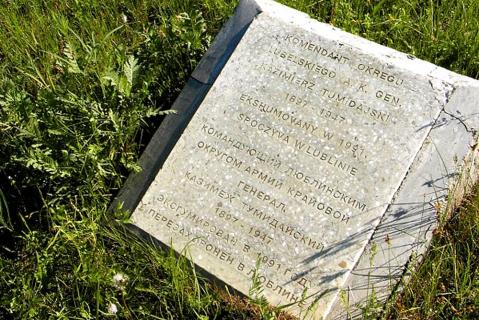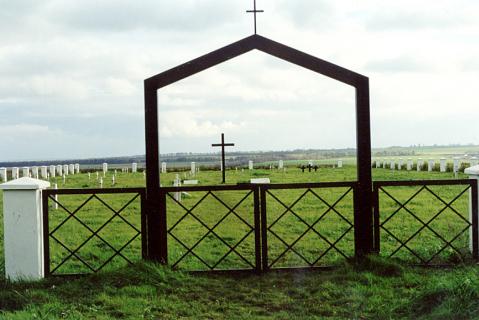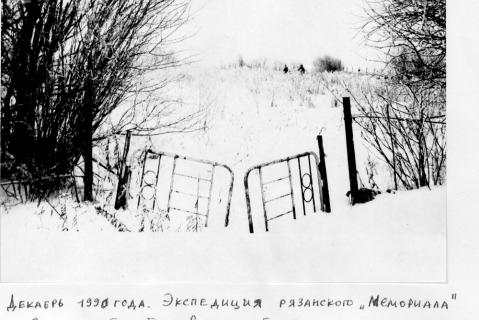From 1944 to 1949 a special NKVD hospital (No. 47-91) for POWs and internees functioned in the Novikovo settlement. Prisoners from camp division No. 178-454 (Ryazan-Dyagilevo) and certain other camps in the Ryazan, Tula and other regions were also sent there. 264 POWs and interned persons lie buried in the hospital cemetery: 201 Germans, 46 Poles, 9 Hungarians and 8 Austrians. POWs and interned persons who died in transit (20 individuals without documents whose names are unknown) were unloaded from troop trains at Skopin rail station, 3.5 kilometres away, and also buried in the cemetery.
The dead were buried in individual graves and, in some cases, in coffins. The graves were marked with metal plates bearing a number on a tall metal stake. The layout of the graves and a list of those buried was compiled by the hospital administration in 1949 when the cemetery closed. In the 1950s to 1980s the territory remained within its original boundary protected by the regime of secrecy as a classified site although the fence collapsed or was falling apart and it was no longer guarded. In the 1980s grass took over the cemetery. A myth circulated among local inhabitants that generals with medals and golden sabres had been buried there. This led to pillaging and the opening of graves; the stakes with their number plates were twisted out of shape.
In 1990-1991 members of the Ryazan Memorial Society determined the location of about 30 individual graves. On only three of the surviving metal stakes could the number be read in full which complicated the work. Common graves were discovered, moreover, that appeared on the plan drawn up by the hospital administration in 1949 as individual graves containing only one body. On 18 July 1991 relatives exhumed the remains of Brigadier-General Kazimierz Tumidajski, who commanded the Lublin district of the Krajowa army, and reburied them that month in the Lublin military cemetery in Poland. An expert examination was conducted during the exhumation to confirm the general’s identity. In 1996, at the suggestion of his daughter, a memorial plaque was placed on his former grave in Skopino. The inscription reads: “Komendant Okręgu Lubelskiego Armii Krajowej generał Kazimierz Tumidajski 1897–1947. Ekshumowany w 1991 roku. Pochowany w ojczyźnie» (General Kazimierz Tumidajski, 1897-1947, commander of the Lublin district of the Krajowa army. Exhumed in 1991 and reburied in his native land.)
In 1992 the Ryazan Region and Skopino district administrations recognised the cemetery of POWs and interned persons as a memorial site. It is under the official custodianship of the German War Graves Commission (Volksbund Deutsche Kriegsgräberfürsorge) that cares for the graves of German soldiers and victims of war and the Polish Council for the Protection of Struggle and Martyrdom Sites (Rada Ochrony Pamięci Walk i Męczeństwa). The Memorial Complex dedicated to the Victims of War and Repression was jointly founded by Ryazan Memorial, the Dikson and Leonardo firms, with the financial support of the German War Graves Commission and the Polish Council. The official opening was on 18 June 1996. The territory of the complex preserves the historical boundary of the cemetery. When the project was under discussion it was decided not to preserve the names and contour of individual graves. The metal stakes were removed and the grounds were levelled off. Symbolic crosses and memorials were installed bearing texts in German, Polish and Russian that indicate the numbers of buried POWs and internees.
On 20 October 1996 all the crosses and the fence were destroyed in an act of vandalism. Work to restore the cemetery was carried out in 1999 with funding from the Ryazan Region administration and the German War Graves Commission. On 20 September that year the complex opened once again. In 2009-2010, Hungarians placed an order with the War Memorials Association (Russia) to install a monument in the cemetery in the form of a cross and two commemorative plaques in memory of all Hungarian POWs who perished in the camps of the Skopino district.
The Memorial online database (2025) lists 23,709 victims in the Ryazan Region (BR 15,897). See Ryazan cemetery.
It names 981 who were shot, most during the Great Terror (846), but the database indicates that many more (1,548) were condemned to death, 1,281 of them in 1937 and 1938. Charges against 1,375 others were dropped (only two deaths in captivity are recorded).
| Date | Nature of ceremonies | Organiser or responsible person | Participants | Frequency |
|---|---|---|---|---|
|
nk
|
civil rites
|
nk
|
foreign delegations
|
from time to time
|
| State of burials | Area | Boundaries |
|---|---|---|
|
have not survived
|
0.4 hectares
|
defined
|




